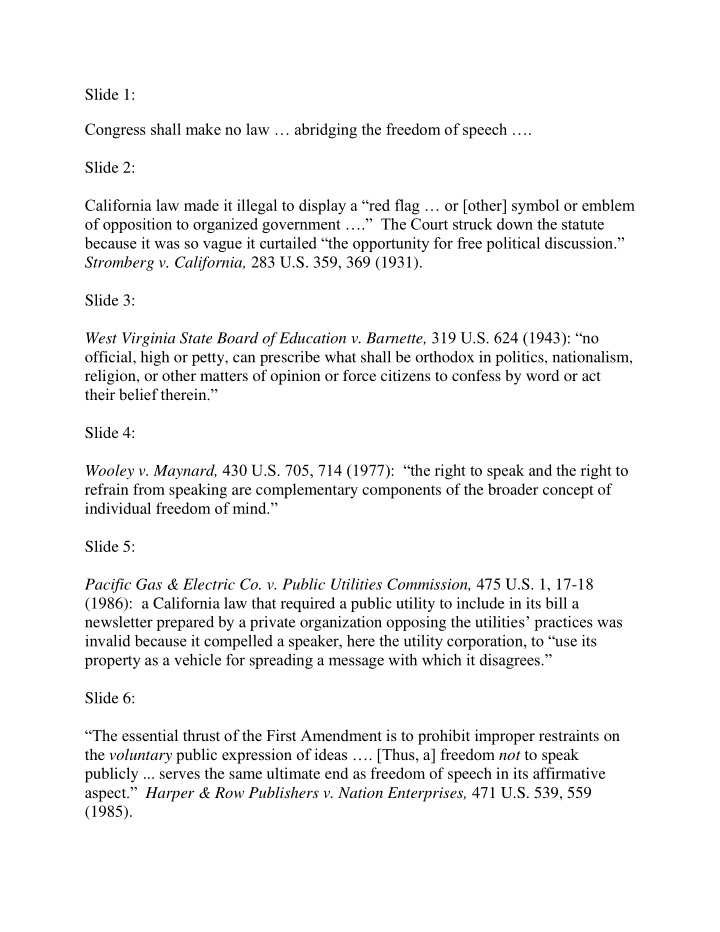



Slide 1: Congress shall make no law … abridging the freedom of speech …. Slide 2: California law made it illegal to display a “red flag … or [other] symbol or emblem of opposition to organized government ….” The Court struck down the statute because it was so vague it curtailed “the opportunity for free political discussion.” Stromberg v. California, 283 U.S. 359, 369 (1931). Slide 3: West Virginia State Board of Education v. Barnette, 319 U.S. 624 (1943): “no official, high or petty, can prescribe what shall be orthodox in politics, nationalism, religion, or other matters of opinion or force citizens to confess by word or act their belief therein.” Slide 4: Wooley v. Maynard, 430 U.S. 705, 714 (1977): “the right to speak and the right to refrain from speaking are complementary components of the broader concept of individual f reedom of mind.” Slide 5: Pacific Gas & Electric Co. v. Public Utilities Commission, 475 U.S. 1, 17-18 (1986): a California law that required a public utility to include in its bill a newsletter prepared by a private organization opposing the utilitie s’ practices was invalid because it compelled a speaker, here the utility corporation, to “use its property as a vehicle for spreading a message with which it disagrees.” Slide 6: “The essential thrust of the First Amendment is to prohibit improper res traints on the voluntary public expression of ideas …. [Thus, a] freedom not to speak publicly ... serves the same ultimate end as freedom of speech in its affirmative aspect.” Harper & Row Publishers v. Nation Enterprises, 471 U.S. 539, 559 (1985).
Slide 7: Virginia State Board of Pharmacy v. Virginia Citizens Consumer Council, Inc., 425 U.S. 748, 761 (1976): commercial speech is entitled to constitutional protection because, in a free- market economy, “the free flow of commercial information is indi spensable.” Slide 8: In cases involving restrictions on commercial speech (i.e., a form of compelled silence), the Court has adopted a four-part test: In commercial speech cases, then a four-part analysis has developed. At the outset, we must determine whether the expression is protected by the First Amendment. For commercial speech to come within that provision, it at least must concern lawful activity and not be misleading. Next, we ask whether the asserted governmental interest is substantial. If both inquiries yield positive answers, we must determine whether the regulation directly advances the governmental interest asserted, and whether it is not more extensive than is necessary to serve that interest. Central Hudson Gas & Electric Corp. v. Public Service Commission of New York, 447 U.S. 557, 566 (1980). Slide 9: In cases involving required commercial disclosures of “factual and non - controversial matters” (i.e., compelled speech), the Court adopted a different and more lenient test: We do not suggest that disclosure requirements do not implicate the advertiser’s First Amendment rights at all. We recognize that unjustified or unduly burdensome requirements might offend the First Amendment by chilling protected commercial speech. But we hold that an advertiser’s rights are adequately protected as long as disclosure requirements are reasonably related to the State’s interest in preventing deception of consumers. Zauderer v. Office of Disciplinary Counsel, 471 U.S. 626, 651 (1985).
Slide 10: United States v. United Foods, Inc. , 533 U.S. 405 (2001): “The program sustained in Glickman differs from the one under review in a most fundamental respect. In Glickman the mandated assessments for speech were ancillary to a more comprehensive program restricting marketing autonomy. Here, for all practical purposes, the advertising itself, far from being ancillary, is the principal object of the regulatory scheme.” Slide 11: Johanns v. Livestock Marketing Association, 544 U.S. 550 (2005): “In [ Johanns ] , unlike the previous two, the dispositive question is whether the generic advertising at issue is the Government's own speech and therefore is exempt from First Amendme nt scrutiny.” Because the structure of the beef marketing program showed that the message at issue was dictated by Congress (promoting beef), and the Secretary had a veto over any generic advertising, there was no First Amendment problem -- citizens have “have no First Amendment right not to fund government speech. And that is no less true when the funding is achieved through targeted assessments devoted exclusively to the program to which the assessed citizens object.”
Recommend
More recommend